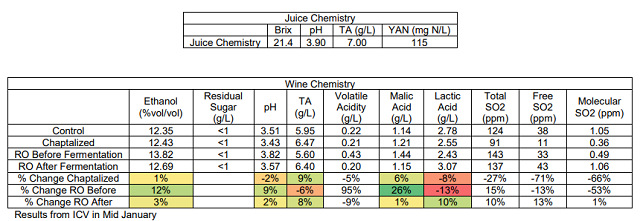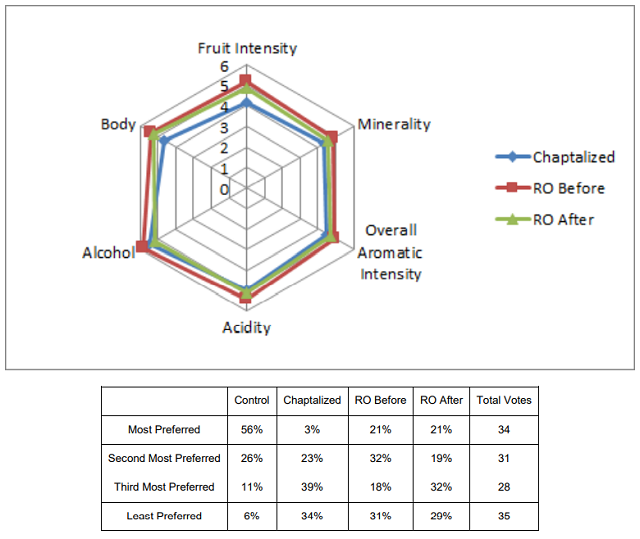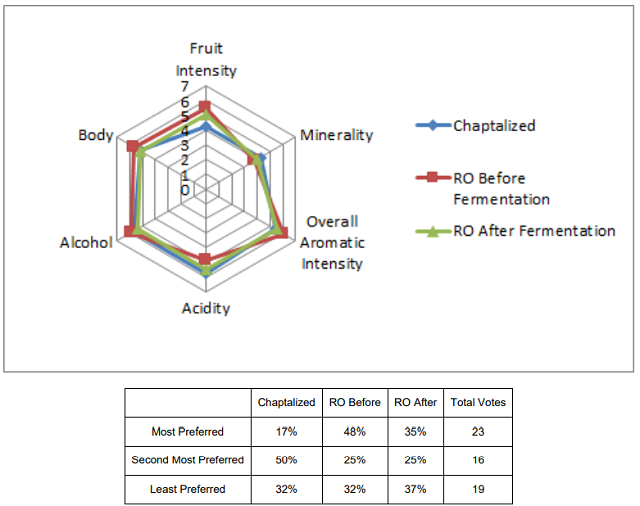Comparison of Reverse Osmosis to Chaptalization in Press Fraction Chardonnay (2017)
Jordan Harris
Tarara Winery
Summary and Introduction
The purpose of this study is to compare reverse osmosis treatments of juice to reverse osmosis treatments on wine, traditional chaptalization techniques, and no treatments at all. These techniques are commonly used in the wake of heavy rainfall events forcing winemakers to pick early. Chardonnay grapes were harvested and pressed into tank. This press fraction juice was allowed to settle overnight, and then was split into three separate lots: 1) Control, 2) Chaptalized, and 3) Reverse Osmosis Before (ROB) Fermentation. The ROB juice was concentrated 15%. After fermentation and malolactic conversion, the control lot was split into two separate barrels, and one of these received another treatment: 4) Reverse Osmosis After (ROA) Fermentation and malolactic conversion, to concentrate 15%. The juice chaptalization treatment was increased by 0.5 Brix in order to produce a potential alcohol which would mimic the ROA alcohol concentration, as opposed to the ROB alcohol concentration. Wines were bottled for the WRE right after the ROA treatment in early January. All other treatments between lots were equal. Alcohol content was highest in the ROB treatment. The ROB wine also had decreased acidity and increased pH, whereas the Chaptalized wine and the ROA wine had slightly increased acidity. Reverse osmosis may have increased the perception of Alcohol, Fruit Intensity, and other descriptors in wine relative to chaptalized wines. Generally, reverse osmosis wines were preferred to the chaptalized wine, but this may have been due to some oxidation in the chaptalized wine.
Results and Discussion
Alcohol content was highest in the ROB treatment. The ROB wine also had decreased acidity and increased pH, whereas the Chaptalized wine and the ROA wine had slightly increased acidity.

For descriptive analysis on January 31, no strong trends were found for the descriptors used in this study. Reverse Osmosis had a slight tendency to increase Fruit Intensity, Minerality, and Body, and RO Before Fermentation had a slight tendency to increase Alcohol. Ignoring the Control wine (due to its being sampled from new oak whereas the rest was sampled from neutral oak), the most preferred wines received Reverse Osmosis; however, judges were relatively split over which they preferred the most. Some judges felt that the Chaptalized wine was oxidized.

For the descriptive analysis on February 7, there was a strong tendency for the RO Before Fermentation treatment to have higher Alcohol intensity and higher Body than the other treatments (LSD=0.30 and 0.41, respectively). There was a slight tendency for RO to increase Fruit Intensity, and for RO Before Fermentation to lower Acidity. The RO Before treatment was most preferred, followed by the RO After Fermentation treatment.

Reverse osmosis may increase the perception of alcohol, fruit intensity, and other descriptors in wine relative to chaptalized wines. Generally, reverse osmosis wines were preferred to the chaptalized wine, but this may have been due to some oxidation in the chaptalized wine.
Methods
Chardonnay grapes from the Hill block (3.15 acre block on limestone rich penn silt loam, south facing, combination of three sub-blocks on a hill, the top planted in 1987 on slightly sandier and high limestone soil, middle planted in 1988 with greater rock and limestone, and bottom planted in 1989 with the least limestone and lowest elevation, 100% cane pruned VSP) were harvested and pressed on September 12, 2017. The yield was 3.55 tons per acre, 1.27 pounds per linear foot cane, and about 0.361 pounds per square foot of canopy (heavier yield than normal). Harvested grapes were chilled overnight, and then destemmed and crushed into the press. Only the press fraction of the top, middle, and lower hill blocks was combined and used for this study. The juice was cold settled overnight with CinnFree. At racking the juice was split into three lots:
- Control
- Chaptalized
- Reverse Osmosis prior to fermentation
The juice which underwent reverse osmosis prior to fermentation was concentrated 15%. The chaptalization was minimal (only 0.5 Brix increase) to mimic the expected potential alcohol of the 4th treatment: reverse osmosis wine after fermentation. YAN was corrected to 175ppm using 25g/hL Fermaid and the remainder DAP over a course of two days for all lots other than the reverse osmosis prior to fermentation treatment, which was corrected to 200ppm YAN due to the higher sugar content. 1.5g/L tartaric acid was added to all lots prior to fermentation.
Fermentation and aging occurred in the same barrel without racking. The barrels were topped after fermentation with a control barrel of Chardonnay from this block. The barrels were all Magrenan Jupilles 2012 (6th fill). Wine was not inoculated for malolactic conversion and was sulfured one week after completion of alcoholic fermentation (October 5). Barrels received batonage by-weekly, except for the fourth treatment:
4. Reverse Osmosis after fermentation and malolactic conversion
This treatment occurred in January and was immediately bottled for the WRE, on the same day as all other treatments. It was concentrated 15%. The remaining wine was returned to the same barrel without cleaning it to keep the lees and keep the project still intact as best as possible for aging. A sampling error occurred on the Control wine at this point, taking wine from a new barrel. As a result, all sensory data on this wine will be ignored.
These wines were tasted on January 31 and February 7, 2018. In order to balance the data set to perform statistical analysis for descriptive analysis on the January 31 tasting, any judge who had not fully completed the descriptive analysis ratings were removed. In order to then make the number of judges between groups equivalent, two judges from group 1 were transferred to group 3, and one judge was transferred from group 1 to group 2. This resulted in a final data set of 3 groups, each with 9 judges (considered as replications within groups, and groups were considered as assessors). Data was analyzed using Panel Check V1.4.2. Because this is not a truly statistical set-up, any results which are found to be statistically significant (p<0.05) will be denoted as a “strong trend” or a “strong tendency,” as opposed to general trends or tendencies. The statistical significance here will ignore any other significant effects or interactions which may confound the results (such as a statistically significant interaction of Judge x Wine confounding a significant result from Wine alone). The descriptors used in this study were Fruit Intensity, Minerality, Overall Aromatic Intensity, Acidity, Alcohol, and Body.
The same procedures for data analysis were used on the February 7 tasting, except that the Control was not tasted due to a strong new oak presence. For the descriptive analysis in this tasting, one judge was transferred from group 1 to group 3, and another judge was eliminated from group one so that each group had 8 judges, for a total of 24 judges.
